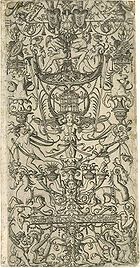
Counter-Mannerism
Encyclopedia

Painting
Painting is the practice of applying paint, pigment, color or other medium to a surface . The application of the medium is commonly applied to the base with a brush but other objects can be used. In art, the term painting describes both the act and the result of the action. However, painting is...
, printmaking
Printmaking
Printmaking is the process of making artworks by printing, normally on paper. Printmaking normally covers only the process of creating prints with an element of originality, rather than just being a photographic reproduction of a painting. Except in the case of monotyping, the process is capable...
and interior decoration that originated as a sub-category of Mannerism
Mannerism
Mannerism is a period of European art that emerged from the later years of the Italian High Renaissance around 1520. It lasted until about 1580 in Italy, when a more Baroque style began to replace it, but Northern Mannerism continued into the early 17th century throughout much of Europe...
. Contra-Maniera (or Counter-Mannerism in English) followed the general worldliness of the second generation of Mannerist painters. It is generally disquieting due to its visionary
Visionary
Defined broadly, a visionary, is one who can envision the future. For some groups this can involve the supernatural or drugs.The visionary state is achieved via meditation, drugs, lucid dreams, daydreams, or art. One example is Hildegard of Bingen, a 12th century artist/visionary and Catholic saint...
style - a style that evolved in Florentine painting as a result of a revolt against the classical balance of the High Renaissance
High Renaissance
The expression High Renaissance, in art history, is a periodizing convention used to denote the apogee of the visual arts in the Italian Renaissance...
art.
An example of the Counter-Mannerist style from the period is the Grotesque
Grotesque
The word grotesque comes from the same Latin root as "Grotto", meaning a small cave or hollow. The original meaning was restricted to an extravagant style of Ancient Roman decorative art rediscovered and then copied in Rome at the end of the 15th century...
, which is deliberately anti-actual, often including elaborate depictions of multiple figures bound in tendrils. The Grotesque (in Italian Grottosesco) became an arabesque
Arabesque
The arabesque is a form of artistic decoration consisting of "surface decorations based on rhythmic linear patterns of scrolling and interlacing foliage, tendrils" or plain lines, often combined with other elements...
style of all-over decoration based on a linked mêlée of fantastic
Fantastic
The Fantastic is a literary term that describes a quality of other literary genres, and, in some cases, is used as a genre in and of itself, although in this case it is often conflated with the Supernatural. The term was originated in the structuralist theory of critic Tzvetan Todorov in his work...
, diminutive figures deriving from Roman mural and vault decoration which had been unearthed during the Renaissance
Renaissance
The Renaissance was a cultural movement that spanned roughly the 14th to the 17th century, beginning in Italy in the Late Middle Ages and later spreading to the rest of Europe. The term is also used more loosely to refer to the historical era, but since the changes of the Renaissance were not...
(such as at the Golden House of Nero); mural decorations which themselves suggested ancient expressions of religio-sexual inter-penetrability. This fanciful imagery involved mixing animal, human, and plant forms together. First revived in the Renaissance by the school of Raphaël
Raphaël
-List of people with the given name Raphaël:*Raphaël Haroche*Raphaël Salem*Raphaël Ibañez*Raphaël Bohren*Raphaël Piolanti*Raphaël Wicky*Raphaël Poulain*Raphaël Nadé*Raphaël Géminiani*Raphaël Alibert*Raphaël Poirée*Raphaël Lévy*Raphaël Jacquelin...
(1483–1520) in Rome, the Grotesque quickly came into fashion in 16th-century Italy and subsequently became popular throughout Europe.
Painters of the style described as Contra-Maniera or Counter-Mannerist
- Domenico Cresti (Il Passignano)
- Lodovico Cigoli
- Jacopo Chimenti da EmpoliJacopo da Empolithumb|250px|Martyrdom of St. Sebastian, [[San Lorenzo di Firenze|San Lorenzo]], [[Florence]].Jacopo da Empoli was an Italian late-mannerist painter....
- Andrea BoscoliAndrea BoscoliAndrea Boscoli was an Italian painter of the Renaissance.He was born in Florence, where he trained under Santi di Tito. He painted a St. John preaching for the church of the Teresiani at Rimino. He also painted portraits. He died about 1606.-References:...
- Gregorio PaganiGregorio PaganiGregorio Pagani was an Italian painter of the late Mannerist period, active mainly in Florence. He was the son of the painter Francesco Pagani, then became a pupil of Santi di Tito, then entered the studio of Ludovico Cigoli. He painted the St. Helena finding the Cross for Santa Maria del Carmine,...
- Santi di TitoSanti di TitoSanti di Tito was an Italian painter of Late-Mannerist or proto-Baroque style, what is sometimes referred to as Contra-Maniera or Counter-Mannerism.-Biography:...
- Bernardino PoccettiBernardino PoccettiBernardino Poccetti , also known as Barbatelli, was an Italian Mannerist painter and printmaker in etching ....
- Giulio Mazzoni Palazzo Capodiferro
- Andrea del SartoAndrea del SartoAndrea del Sarto was an Italian painter from Florence, whose career flourished during the High Renaissance and early Mannerism. Though highly regarded during his lifetime as an artist senza errori , his renown was eclipsed after his death by that of his contemporaries, Leonardo da Vinci,...
- Francesco CurradiFrancesco CurradiFrancesco Curradi was an Italian painter of the style described as Contra-Maniera or Counter-Mannerism, born and active in Florence....
- Antonio TempestaAntonio TempestaAntonio Tempesta was an Italian painter and engraver, a point of connection between Baroque Rome and the culture of Antwerp. He was born and trained in Florence and painted in a variety of styles, influenced to some degree by "Contra-Maniera" or Counter-Mannerism...
- Francesco CurradiFrancesco CurradiFrancesco Curradi was an Italian painter of the style described as Contra-Maniera or Counter-Mannerism, born and active in Florence....
- Maso da San FrianoMaso da San FrianoMaso da San Friano was an Italian painter active in Florence. His real name was Tomaso D'Antonio Manzuoli. He was born in San Friano and died in Florence....

